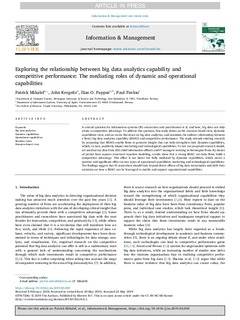| dc.contributor.author | Mikalef, Patrick | |
| dc.contributor.author | Krogstie, John | |
| dc.contributor.author | Pappas, Ilias | |
| dc.contributor.author | Pavlou, Paul | |
| dc.date.accessioned | 2019-11-28T13:20:32Z | |
| dc.date.available | 2019-11-28T13:20:32Z | |
| dc.date.created | 2019-06-25T14:37:57Z | |
| dc.date.issued | 2019 | |
| dc.identifier.citation | Information & Management. 2019, 1-15. | nb_NO |
| dc.identifier.issn | 0378-7206 | |
| dc.identifier.uri | http://hdl.handle.net/11250/2630917 | |
| dc.description.abstract | A central question for information systems (IS) researchers and practitioners is if, and how, big data can help attain a competitive advantage. To address this question, this study draws on the resource-based view, dynamic capabilities view, and on recent literature on big data analytics, and examines the indirect relationship between a firm’s big data analytics capability (BDAC) and competitive performance. The study extends existing research by proposing that BDACs enable firms to generate insight that can help strengthen their dynamic capabilities, which, in turn, positively impact marketing and technological capabilities. To test our proposed research model, we used survey data from 202 chief information officers and IT managers working in Norwegian firms. By means of partial least squares structural equation modeling, results show that a strong BDAC can help firms build a competitive advantage. This effect is not direct but fully mediated by dynamic capabilities, which exerts a positive and significant effect on two types of operational capabilities: marketing and technological capabilities. The findings suggest that IS researchers should look beyond direct effects of big data investments and shift their attention on how a BDAC can be leveraged to enable and support organizational capabilities. | nb_NO |
| dc.language.iso | eng | nb_NO |
| dc.publisher | Elsevier | nb_NO |
| dc.rights | Attribution-NonCommercial-NoDerivatives 4.0 Internasjonal | * |
| dc.rights.uri | http://creativecommons.org/licenses/by-nc-nd/4.0/deed.no | * |
| dc.title | Exploring the relationship between big data analytics capability and competitive performance: The mediating roles of dynamic and operational capabilities | nb_NO |
| dc.type | Journal article | nb_NO |
| dc.type | Peer reviewed | nb_NO |
| dc.description.version | publishedVersion | nb_NO |
| dc.source.pagenumber | 1-15 | nb_NO |
| dc.source.journal | Information & Management | nb_NO |
| dc.identifier.doi | 10.1016/j.im.2019.05.004 | |
| dc.identifier.cristin | 1707693 | |
| dc.description.localcode | © 2019. This is the authors’ accepted and refereed manuscript to the article. This manuscript version is made available under the CC-BY-NC-ND 4.0 license http://creativecommons.org/licenses/by-nc-nd/4.0/ | nb_NO |
| cristin.unitcode | 194,63,10,0 | |
| cristin.unitname | Institutt for datateknologi og informatikk | |
| cristin.ispublished | true | |
| cristin.fulltext | postprint | |
| cristin.qualitycode | 1 | |

